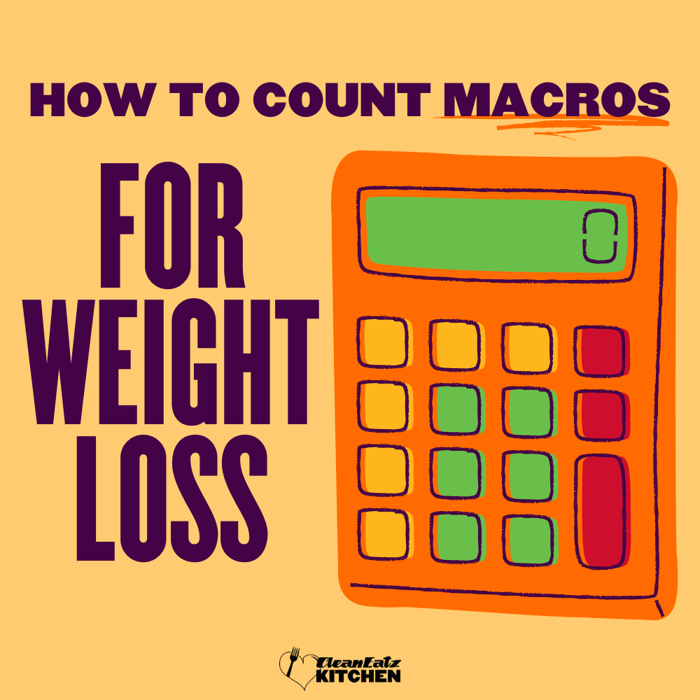How to Count Macros for Weight Loss

Jason Nista
Exercises & Fitness
|
Weight Loss
12/05/2022 12:00pm
7 minute read
Counting calories doesn't work for you but you still want to keep track of what you are eating? Counting macros might be what you need.
Instead of keeping track of every single calorie you eat, macro counting only keeps track of how much of your total energy intake comes from each macronutrient respectively. However how to count macros for weight loss?
Keep reading to learn more about the following points that we are going to discuss further in the article:
- Macros and their types
- How to count macros?
- How it can be used for weight loss?
What are Macros?
Macronutrients, also known as macros, are essential nutrients that supply us with energy to fuel our bodies and support various physiological functions. There are three primary macronutrients: carbohydrates, proteins, and fats.
Carbs
In a typical diet, carbohydrates tend to be the most consumed macronutrient. About 30 to 45% of energy in the typical Western diet comes from carbohydrates. Carbohydrates can be classified into three main categories; sugars, starch, and fiber.
Sugar and starch are digestible forms of carbohydrates while fiber isn’t. This means that the body isn’t able to break down fiber to produce energy. For each gram of digestible carbohydrate, the body produces about 4 calories of energy.
Foods rich in carbohydrates are potatoes, rice, oats, fruits, vegetables, and sweet treats. On a weight loss diet, try to get most of your carbohydrates from whole foods rather than processed foods. This is because processed foods tend to be higher in sugar and low in fiber, a combination that works against your weight loss efforts.
Protein
Similar to carbohydrates, each gram of protein yields 4 calories of energy. Protein plays multiple roles in the body including growth, maintenance, and repair of body tissues, synthesis of hormones, enzymes, and antibodies, and transport of molecules like cholesterol.
It is recommended that about 20 to 35% of your energy should come from protein. However, protein recommendations vary with age, gender, goals, and state of health. While most people get enough protein in their diets, they tend to consume most of it with heavier meals such as lunch and dinner.
On a weight loss diet, it might be beneficial to try and incorporate protein at all or most of your meals including breakfast and snacks. High-protein meals help to keep you full for longer after meals because protein is one of the slowest digesting nutrients.
Sources of protein include meat, poultry, fish, legumes, nuts, dairy, seeds, and protein supplements.
Fats
Even though fat yields the most calories out of all the macronutrients, it is still necessary even on a weight loss diet. Each gram of fat comes out to about 9 calories, more than twice the energy yield of proteins and carbohydrates.
The key to incorporating fat into your diet is choosing high-quality sources of fat like in Keto meal delivery packages. These include oily fish, avocado, nuts, and seeds.
Limit low-quality sources of fat such as fried chicken, french fries, and sweet condiments.
How to Count Macros for Weight Loss
Calculating macros for weight loss is an essential aspect of many successful weight loss strategies. By understanding and tracking the macronutrient composition of your diet, you can optimize your nutrient intake to support your weight loss goals effectively.
Macros are expressed as percentages of your total energy intake. For example, if your diet is 30% carbohydrates, that means that 30% of your total energy intake comes from carbohydrates.
To get a picture of how to count macros for weight loss, follow the steps below:
Calculate your total energy intake
Since macros are expressed as a percentage of your total energy intake, you must have an idea of how much energy you consume every day.
There are many ways to find out your daily calorie intake. Since you have to burn more calories than you consume to lose weight, you may choose to calculate your energy expenditure first and try to aim for a lower energy intake. You may also choose to calculate your energy from the food you eat on your weight loss meal plan.
Choose the macro distribution that supports your goals
While there are current recommendations for macro intake, you may choose to follow another distribution that better supports your goals.
For example, if you are following the ketogenic diet, your carbohydrate intake will be about 10% or less. Or if you are trying to control your blood sugar levels, you might want to keep your carb intake at about 35% or lower.
Estimate your macro intake
If you already had a diet in place for your weight loss journey, you can use online tools to track the macronutrient composition of your food.
To do this, you will have to know how much of each food you are consuming. Enter the amount into the app and it will do all the math for you. At the end of the day, the app will show you your macro distribution at which point you can decide if it suits your weight loss goals or not.
Final Thoughts
In summary, counting macros is a beneficial approach for tracking nutrition and achieving weight loss goals. Unlike calorie counting, which focuses solely on energy intake, counting macros for weight loss considers the specific percentages of carbohydrates, proteins, and fats in the diet. This personalized approach allows for mindful eating, portion control, and a better understanding of nutrient composition. By manipulating macro ratios, creating an energy deficit becomes possible. It is essential to prioritize whole foods, distribute protein intake, and choose high-quality sources of fats. How to count macros for weight loss? There are various online calculators available.
FAQs
How do I calculate my macros for weight loss?
To calculate your macros for weight loss, you need to follow a few steps. First, determine your daily calorie intake based on your total daily energy expenditure (TDEE). Next, set a calorie deficit. After setting your calorie deficit, determine your desired macro distribution. Once you have decided on your macro distribution, you can calculate the grams of each macro. Many online calculators and tracking apps can help with this. They will use your calorie intake and macro distribution to determine the specific grams of carbohydrates, proteins, and fats you should aim for.
What is the best macro ratio for fat loss?
The best macro ratio for fat loss differs from person to person. This is because everyone is different and has different goals and desires. However, it is generally encouraged to get enough protein and high-quality carbohydrates and fat.
Should I count macros?
Counting macros can provide insight into your nutrient intake and help ensure you're meeting your individual needs. It allows for a more flexible approach to eating, as you can customize your macros to fit different dietary preferences, such as low-carb or high-protein. However, it's important to consider your lifestyle and whether tracking macros aligns with your personal preferences and sustainability in the long term. Consulting with a registered dietitian can provide guidance on whether counting macros is appropriate for you and help you navigate the process effectively.
Is it better to count calories or macros?
Whether it's better to count calories or macros depends on individual preferences and goals. Counting calories focuses on overall energy intake while counting macros provides a more detailed breakdown of the specific nutrients in your diet. Counting calories can be simpler and more straightforward, as it involves monitoring the total energy content of the foods you consume. It can be effective for weight management, as creating a calorie deficit is crucial for weight loss. On the other hand, counting macros offers a more nuanced approach to nutrition by considering the distribution of carbohydrates, proteins, and fats.
Related Articles
What Are Isometric Exercises?
4 minute read



